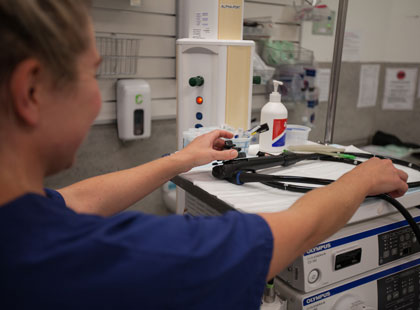Colonoscopy

What is colonoscopy?
This procedure involves a colonoscope – a long, thin flexible tube with a ‘video camera’ at the tip – being passed through the rectum into the colon. It allows the doctor to inspect the large intestine and also perform specialised procedures such as biopsies and removal of polyps.
Why have a colonoscopy?
Colonoscopy can detect inflamed tissue, ulcers and abnormal growths such as polyps and cancer. The procedure is most commonly used to look for early signs of colorectal cancer however can also can help doctors diagnose unexplained changes in bowel habits, abdominal pain, bleeding from the bowel and weight loss. For individuals with a family history of bowel cancer, this is an appropriate test to check for bowel polyps before they turn into bowel cancer.
How is colonoscopy performed?
Sedation
Before the procedure an anaesthetic (sedative) is given. All procedures done by Sam have an anaesthetist present ensuring you are comfortable throughout the procedure. Most colonoscopies in public hospitals in SA do not have an anaesthetist present.
Examination of the bowel
Once sedated and lying in a comfortable position on your left side, a flexible colonoscope (‘scope’) is inserted through the anus and slowly guided into the colon. A small camera in the end of the scope transmits a video image to a monitor, allowing careful examination of the intestinal lining. Once the scope has reached the opening to the small intestine, it is slowly withdrawn and the lining of the large intestine is carefully examined again. A colonoscopy usually takes between 15 and 20 minutes.
Removal of polyps and biopsy
A polyp is a small tissue growth attached to the bowel wall., Most colorectal cancer begins as a polyp so removing them early is an effective way to prevent cancer. If polyps are found during the procedure they will be removed using tiny tools passed through the scope. Small tissue samples or biopsies of the bowel may also be taken for examination. This allows the pathologist to review it with a microscope for signs of disease.
What happens after colonoscopy?
Following the procedure you will remain in the recovery area for an hour until the sedation medication wears off. You will be given something light to eat and drink once you are awake. Because of the sedation given during the procedure, it is very important that you do not drive a car, travel on public transport alone, operate machinery, sign legal documents or drink alcohol on the same day after the test. You will need a partner, friend or relative take you home and stay with you.
Full recovery is expected by the next day. Discharge instructions should be carefully read and followed.
How do I prepare for colonoscopy?
For a successful colonoscopy, it is essential to empty the bowel thoroughly of all waste material, which can be done by taking a bowel preparation (see below). Failure to do this prior to colonoscopy may mean the doctor won’t be able to see important markers, or you may have to return for another procedure.
A complete bowel preparation consists of:
1. Modifying your diet. This may involve following a special diet for several days prior to the colonoscopy.
2. Taking a bowel preparation medication. There are several effective bowel preparations (laxative medication that causes diarrhoea and empties the colon) available and, depending on your medical condition, the doctor will recommend the right one for you.
3. Increasing your fluid intake. Specific preparation instructions will be given to you by your doctor. Patients should also inform the doctor of all medical conditions and any medications, vitamins or supplements taken regularly.
